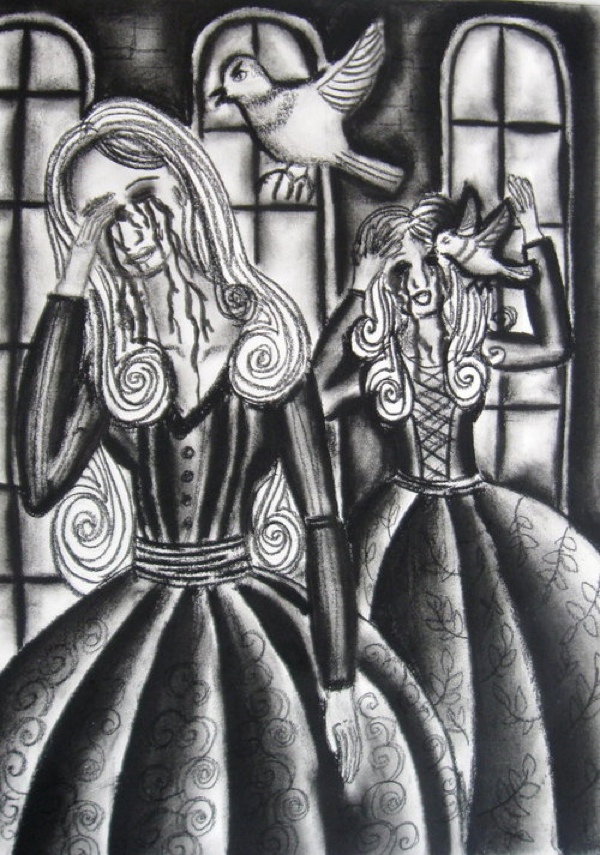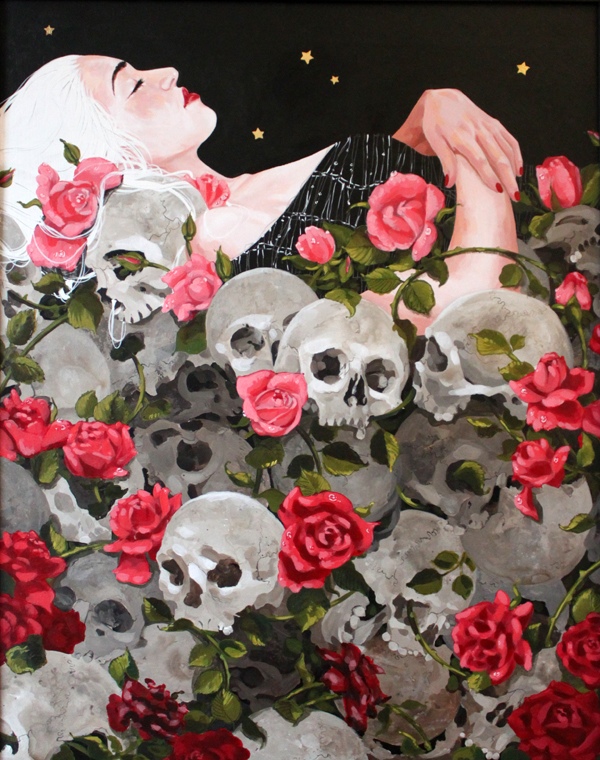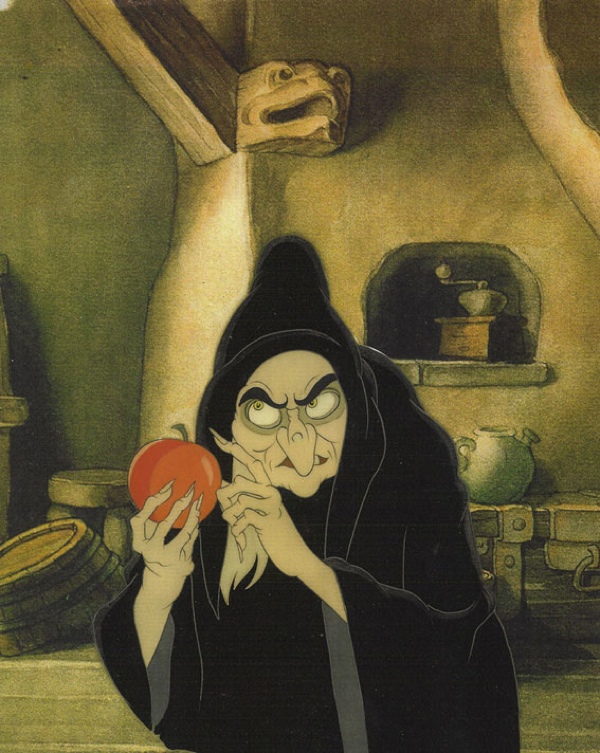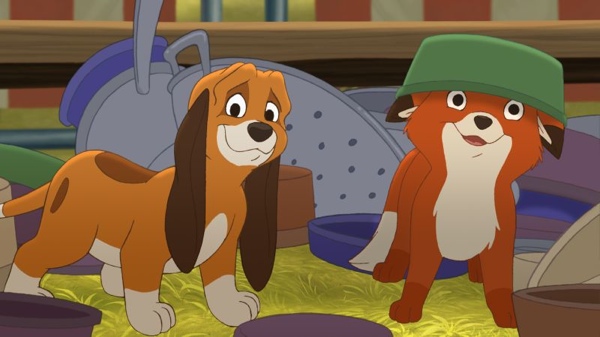 Miscellaneous
Miscellaneous  Miscellaneous
Miscellaneous  History
History 10 Great Escapes That Ended Right Back in Captivity
 Weird Stuff
Weird Stuff 10 Fascinating Things You Might Not Know About Spiders
 Food
Food 10 Everyday Foods You Didn’t Know Were Invented by the U.S. Military
 History
History 10 Odd Things Colonial Americans Kept at Home
 Weird Stuff
Weird Stuff 10 Superstitious Beliefs That Once Consumed Entire Cultures
 History
History 10 Bizarre Friendly Fire Incidents in Military History
 Technology
Technology 10 Modern Technologies That Accidentally Imitate Ancient Magic
 Mysteries
Mysteries 10 Mysteries of the Human Genome
 Weird Stuff
Weird Stuff 10 Things So Rare They’ve Only Been Found Once
 Miscellaneous
Miscellaneous 10 of History’s Most Bell-Ringing Finishing Moves
 History
History 10 Great Escapes That Ended Right Back in Captivity
 Weird Stuff
Weird Stuff 10 Fascinating Things You Might Not Know About Spiders
Who's Behind Listverse?

Jamie Frater
Head Editor
Jamie founded Listverse due to an insatiable desire to share fascinating, obscure, and bizarre facts. He has been a guest speaker on numerous national radio and television stations and is a five time published author.
More About Us Food
Food 10 Everyday Foods You Didn’t Know Were Invented by the U.S. Military
 History
History 10 Odd Things Colonial Americans Kept at Home
 Weird Stuff
Weird Stuff 10 Superstitious Beliefs That Once Consumed Entire Cultures
 History
History 10 Bizarre Friendly Fire Incidents in Military History
 Technology
Technology 10 Modern Technologies That Accidentally Imitate Ancient Magic
 Mysteries
Mysteries 10 Mysteries of the Human Genome
 Weird Stuff
Weird Stuff 10 Things So Rare They’ve Only Been Found Once
10 Disney Movies With Horrific Origins
As many people know by now, some of Disney’s much loved animated musicals, beloved and enjoyed by so many happy little children for the past eighty years, have truly horrific origins involving rape, cannibalism, torture and other very nasty happenings. Some people believe Disney improved the original stories, making them more accessible and enjoyable to the general public, others are of the opinion that Disney mauled them, or at least failed completely to do them justice.
Here are ten examples of some of the lesser-known origins of Disney’s movies, some going back in history to sources that many people are unaware of, others revealing origins that haven’t previously been discussed in such detail on the internet.
Whatever your own personal opinions of these disturbing origins and Disney’s popular renditions of them, I hope you enjoy reading this list as much as I enjoyed writing it.

Original: Pinocchio Kills the Cricket, the Fairy is a Walking, Talking Corpse and Pinocchio Dies
In the very first version of Pinocchio, the marionette is punished by death for being such a naughty boy. Pinocchio teases Gepetto mercilessly and runs away, Gepetto chases him but is caught by a police officer who throws the old man in prison, believing he is abusing the puppet. When Pinocchio returns to Gepetto’s house he meets a hundred year old cricket who tells him naughty boys turn into donkeys. Pinocchio throws a hammer at the cricket and kills it.
Pinocchio ends up nearly getting burned as fire wood, he then bites off an evil cat’s paw and meets a beautiful blue haired fairy who tells him she is dead and waiting for people to take her body away. Pinocchio then gets hung from a tree by the cat with the mutilated paw and the cat’s companion the fox, and they watch as Pinocchio suffocates to death. The End.
The editors weren’t too happy with this ending, so the author added a second part to the story. Here, the beautiful dead fairy rescues Pinocchio and they start living together, but Pinocchio takes up his wicked ways again and eventually turns into a donkey. He is sold to the circus, where he goes lame.
Pinocchio is then brought by a musician, who desires to kill him, skin him, and turn him into a drumhead. The musician ties rocks to the donkey’s neck and lowers him into the ocean to drown. As he drowns, fish eat the flesh off his bones, and the wooden marionette skeleton is left. Pinocchio swims away, but is swallowed by a giant shark, in whose stomach he finds Gepetto sitting at a table trying to eat live fish which keep wriggling out of his mouth. After they escape, Pinocchio busies himself with caring for Gepetto, and eventually as a reward for being a good lad, looking after his father and working hard, he is rewarded by being turned into a real boy.
Watch this horrifying movie and thousands more with a free 30-day trial of Amazon Prime at Amazon.com!

Original: Cassim Gets Dismembered
Who the hell is Cassim you ask? Cassim is Aladdin’s long lost father in Disney’s direct-to-video third Aladdin movie; Aladdin and the King of Thieves. In the movie, Cassim, who is the leader of the infamous Gang of Forty Thieves, gives up his wicked ways to attend Aladdin and Jasmines long awaited wedding. Some concepts for the movie were inspired by Ali Baba and the Forty Thieves, a tale from 1001 Nights.
In the original version, Ali Baba learns the secret words into and out of the Forty Thieves magical secret treasure trove. Ali Baba reveals the words to his brother Cassim, who rushes to the trove to greedily collect as much gold as he can carry. In his excitement though, he forgets the magic words to get out of the cave. The thieves return, find Cassim and kill him. They divide his corpse into quarters and place the dismembered portions outside the opening of their cave as a warning to future robbers.
When Ali Baba discovers the macabre warning sign, he collects the portions of his brothers’ body and carries them home with him. He asks a slave girl, Morgiana, to make it look as if Cassim died of natural causes. Morgiana finds a skilled tailor, who expertly sews the pieces of Cassim’s corpse back together. The thieves discover where Ali Baba lives, but the slave girl ends up tricking them into killing two of their own, and she kills the rest by pouring boiling oil into the jars where they are hiding. The leader is the only one left, and Morgiana stabs him to death during dinner at Ali Baba’s house. Now that’s one loyal slave!

Original: Cinderella Kills Her Step-Mother
By now, most of us know about the Grimm’s version of Cinderella, where the Prince spreads tar on the palace steps in the hopes that Cinderella will get stuck as she tries to flee. His plan fails however, and only her shoe is left sticking in the tar. Her sisters, who are “beautiful but black of heart” both attempt to fool the Prince into marrying them. One sister slices off her big toe so that she may fit the slipper, the other slices off her own heel. Their deceit is unmasked when Cinderella’s enchanted birds point out the blood on their stockings to the Prince. The sister’s eyes are pecked out as punishment for their cruelty and deceit. Though this is an excellent version of Cinderella, this is not the version Disney actually based their movie on.
Disney’s Cinderella was based on a very tame story by Charles Perrault, published 1697. Perrault’s version plays out almost exactly like the Disney version. However, both Perrault’s and Grimm’s versions contain elements from The Cat Cinderella, published in 1634, by Giambattista Basile. Though tame for a Basile fairy tale, it is worth noting that in this version, Cinderella confides in her seemingly kind Governess about the cruelty of her step-mother. The Governess tells Cinderella that to fix her problem she will need to kill her step-mother by slamming the lid of a large wooden chest down on her step-mothers throat, which will break her neck.
Cinderella must then convince her father to marry the Governess. Cinderella kills her step-mother and the marriage goes ahead. It turns out though that the Governess was hiding her own seven beautiful daughters out of sight, and when she produces them, Cinderella’s father loses interest in his own daughter. They all start to mistreat Cinderella, abusing her and calling her names, and she is sent to the kitchens to work as a servant (she is now given the name ‘Cat Cinderella’. previously her name was Zezolla). The rest of the story carries like a traditional Cinderella tale, and actually has a happy ending all round, but it’s nice to know that Cinderella wasn’t always so innocent.

Original: Sleeping Beauty Slumbers Amongst Hundreds of Rotting Corpses Trapped in a Briar Hedge
In the Brothers Grimm tale of Briar Rose, a wise woman curses the baby princess so that in her fifteenth year she will prick her finger on a spindle and fall down dead. Another wise woman weakens the curse so that, instead of dying, the princess will fall asleep for a hundred years. Surely enough, in her fifteenth year, the girl pricks her finger and falls into a deathlike sleep, which quickly spreads throughout the entire kingdom until even the flies on the wall slumber. A briar hedge grows up around the castle and, over the years, hundreds of young men from faraway lands try to make their way through the brambles to ‘gaze upon’ the sleeping princess.
However the brambles are so thick that the young men get trapped in the thorns and die slow miserable deaths. On the hundredth year a prince rides by and the brambles turn into flowers and open for him because the curse has finally run out. The prince finds the Sleeping Beauty and kisses her as she awakens.
As mentioned in a previous Listverse list, the Brothers Grimm took inspiration for Briar Rose from Sun, Moon and Talia, written by Giambattista Basile. In this tale, a king rapes the princess as she sleeps. She is impregnated and gives birth to twins. One of the babies sucks the enchanted splinter from beneath her fingernail and she awakens. The queen attempts to have the babies slaughtered and fed to their father, and attempts to burn Talia alive, but the king saves the day just in time, the queen is burned in Talia’s place, and they all live happily ever after.

Original: The Little Mermaid Kills the Prince
In the Hans Christian Andersen story that Disney based their movie on, the little mermaids tongue is cut out. She has to live in horrific pain and her feet bleed ceaselessly, then the prince marries another woman anyway. The little mermaid has a choice; she can kill the prince and turn back into a mermaid, or throw herself into the ocean and die. Unable to kill the prince, she commits suicide.
Though The Little Mermaid is an Andersen original, he took inspiration from a tale called Undine, by Friedrich de la Motte Fouqué. In Undine, a knight marries a water spirit and she gets a human soul. Undine’s spirit relatives are mischievous and at times quite evil, and they begin to complicate the marriage. It doesn’t help that Undine lets her husband’s ex-girlfriend, Bertilda, who is also Undines half-sister, live with them at the castle. The knight falls in love with Bertilda, and they both begin to treat Undine badly which makes her uncle, a powerful water spirit, very angry.
Undine commits suicide by throwing herself into a raging river to save her husband and Bertilda from the wrath of her uncle. She loses her human soul and becomes a spirit again. The knight believes she is dead and marries Bertilda, but this is a big no-no if you have previously been married to a water spirit. Undine is forced by spirit protocol to return in her water nixie form and kill her ex-husband! After he is buried, a tiny stream appears and circles his grave; thus, Undine and the knight remain together forever in death.
Now watch the story you grew up with! Buy The Little Mermaid at Amazon.com!

Original: Snow White is Tortured and Made into a Slave
In the brothers Grimm tale of Snow White, the evil Queen orders a hunter to bring back Snow White’s lungs and liver as proof of the Princess’s demise. The huntsman brings back the entrails of a pig and the Queen, believing them to be the liver and lungs of Snow White, greedily devours the glistening organs.
The Queen tries to kill Snow White three times: First she pulls Snow Whites corset so tight that she passes out. Second she brushes Snow Whites hair with a poisoned comb, which causes her to fall into a deathlike sleep, the dwarfs remove the comb and she awakens. Finally, the Queen poisons an apple which Snow White eats and apparently dies. The dwarfs place her corpse in a glass coffin where a passing Prince finds her and decides to take her home with him. As the coffin is moved, the piece of apple falls from Snow Whites throat and she awakes. At the wedding, the Queen is put into red hot iron shoes and made to dance until she dies.
Grimm’s borrowed ideas for their tale of Snow White from a story called The Young Slave, written by Giambattista Basile in 1634. In this story, a baby is cursed to die in her seventh year by a fairy. When the girl turns seven, her mother is combing her hair and the comb becomes lodged in the girl’s skull, apparently killing her. The mother places the girl into seven crystal coffins, placed one inside the other, and locks her in a chamber in the castle. The mother eventually dies of grief, and entrusts the key to the chamber to her brother, telling him never to unlock the door. The brother’s wife gets hold of the key, opens the door, and finds a beautiful young woman inside the glass coffins (the girl continued to grow as she slept).
The wife thinks her husband is keeping the girl locked in the room to have sex with her, so drags her out by her hair, which dislodges the comb and breaks the spell. The wife cuts of the girl’s hair off and whips her bloody with the tresses. She then makes the girl her slave and beats her daily, giving her black eyes and making her mouth so bloody it looks as though she’s been “eating raw pigeons.” The young woman decides to kill herself but as she is sharpening the blade she tells her story to a doll. Her uncle overhears and the plot is revealed. He sends his wife away, gets medical attention for his niece, and then marries her off to a rich man.

Original: Hercules Burned Himself Alive
Zeus, God of the sky, disguises himself as a man called Amphitryon. Why? So Zeus could have sex with Alcmene, Amphitryon’s hot wife! Zeus impregnates Alcmene after raping her. The real Amphitryon has sex with Alcmene the same night and also impregnates her, thus, she is pregnant with two babies both from different fathers! (This is physically possible incidentally.) One of the twins (Zeus’s son) is Heracles (this was the original spelling, which means “Glory of Hera.” He was given this name pretty much just to annoy Hera).
When Heracles grows up he becomes a great warrior and marries the beautiful princess Megara. They have two beautiful babies whom Heracles then slaughters when he is driven into temporary madness by Hera. Some mythologies say Heracles also killed Megara, others say he gave her to Iolaus, who was not only Heracles nephew, but also his young lover! (Heracles was a symbol of sexual prowess, having love affairs with multiple men and women.)
Later, when the centaur Nessus tries to rape Heracles fourth wife Deianeira, Heracles shoots him with arrows poisoned with the blood of the Hydra. As he dies, Nessus tells Deianeira to collect his spilled blood and semen and use it as a love potion. When Deianeira eventually begins to worry about Heracles faithfulness, she smears the potion onto a sacrificial tunic which Heracles then dons.
The venom of the Hydra (which entered Nessus’s blood when the poisoned arrow pierced him) begins to burn Heracles skin and he tears the shirt off but his skin rips off as well, exposing his bones. Deianeira hangs herself in horror. To end his excruciating agony, Heracles has a funeral pyre built and his friend Philoctetes lights the fire. Heracles burns himself alive, but instead of dying, the immortal part of his body is left after his human flesh burns away and Heracles returns to Olympus as an immortal, reconciles with Hera and presumably lives happily ever after.

Original: The Fox and the Hound: They All Die Miserably
Copper hates Chief; a younger, faster hunting dog who is taking Coppers place in the pack. After Chief saves their Master from an attacking bear during a hunt, Coppers hate and jealousy grow steadily stronger. The Master heaps praise on Chief but ignores Copper, who cowered in fear when the bear attacked. Tod is a fox who delights in taunting the chained dogs and driving them into a frenzy. One day Chief breaks his chain and trails Tod. Tod leads the dog onto a railroad track and Chief is hit by a train and killed. The Master swears vengeance and trains Copper to ignore all other foxes except Tod.
Tod meets an older vixen and they have a litter, but the Master and Copper find the den and gas the baby foxes. The vixen is then caught in a leg trap and killed.
Tod meets another vixen and has more babies, but again his family is slaughtered by the Master. One winter, there is a rabies outbreak among the foxes, who are now scavengers. One of the infected foxes attacks a group of human children and the Master puts poison out to try and kill as many foxes as possible. A human child eats the poison and dies.
Tod escapes many more attempts on his life, but one day Copper hunts Tod so relentlessly that Tod drops dead of exhaustion. Copper is almost dead himself, but the Master nurses him back to health. They enjoy some new found popularity, but the Master starts drinking again and eventually ends up having to go into a nursing home. The master takes his shotgun and shoots Copper dead, weeping as he does so. The End.

Original: Quasimodo Gets Tortured, Esmeralda Gets Tortured and then Everybody Dies
Frollo doesn’t try to drop the deformed baby down a well like in the Disney movie. In Victor Hugo’s dark original Frollo actually rescues the baby from being burned alive by four women who think it is a demon. Frollo adopts the baby and names him Quasimodo. Frollo is eventually driven mad with lust to dominate a beautiful fifteen year old gypsy girl called Esmeralda and makes Quasimodo kidnap her.
Quasimodo is caught in the act and arrested by the handsome soldier Phoebus, whom Esmeralda falls in love with. Quasimodo is publicly tortured and left exposed in the pillory. Phoebus (who’s already engaged but he’s a total slut) arranges a ‘private rendezvous’ between him and Esmeralda, but Frollo pays Phoebus to let him hide in the shadows and spy on them. Esmeralda, overcome by lust, gives up her vow of chastity to Phoebus, who gets right down to business. Overcome with jealousy, Frollo emerges from the shadows, stabs Phoebus in the back and flees into the night. Esmeralda is charged with the attempted murder, tortured into giving a false confession in a subterranean dungeon, and sentenced to hang.
Quasimodo rescues her as she is led to the gibbet and hides her in Notre Dame, where Frollo tries to rape her. After Quasimodo again intervenes, Frollo gives Esmeralda up and there is a brief and bloody battle during which Frollo tells her he will rescue her if she will ‘give her love’ to him. She refuses and he hands her over to the troops. Frollo watches as Esmeralda is executed, and laughs hysterically as she writhes at the end of the rope. Quasimodo then throws Frollo from the heights of Notre Dame.
Quasimodo then crawls into the crypt where the corpses of executed criminals are left to rot and wraps himself around Esmeralda’s decaying cadaver. Eventually their two skeletons are found, wrapped in an eternal embrace.

Original: Pocahontas was Kidnaped, Raped and Murdered
The two Disney movies about the curvaceous, scantily-clad Native Indian beauty are based on sterilized and falsified English accounts of the early history of the Virginia Colony. Pocahontas was only around ten years old when Smith first made contact with the Powhetans. It is true that he was captured by the tribe, but in his original account of the event Smith relates that he was treated very kindly. It wasn’t until many years later, when Pocahontas’s name became known in England, that Smith fabricated the story about her rescuing him from execution.
When Pocahontas was seventeen, she was captured by the English and held for ransom. Her husband Kokoum was killed and Pocahontas was raped repeatedly and consequently impregnated. She was forcefully converted to Christianity, baptized Rebecca, and quickly married off to an English tobacco farmer named John Rolfe to make the pregnancy appear legitimate. In 1615 the Rolfe’s travelled to England and Pocahontas was laced into a corset and presented to the public as a ‘symbol of the tamed Virginia savage’.
After two years in England the Rolfe’s had begun their journey home to Virginia when Pocahontas suddenly started to vomit violently after dinner, she then began to convulse. Before they had even sailed off the river Thames Pocahontas had died, horribly and painfully. English historical accounts are ‘unsure of the cause of death’, speculating that she may have succumbed to pneumonia, tuberculosis, or even smallpox. However, in their book The True Story of Pocahontas; The Other Side of History Linwood Custalow and Angela L. Daniel postulate that during her time in England, Pocahontas learned of the English intentions to obliterate the Native Indian Tribes and forcefully take their lands. Afraid that Pocahontas might reveal their political strategies, her murder was swiftly plotted and she was poisoned before she could reach home and report what she had learned. Pocahontas was only twenty-two years old when she died.








